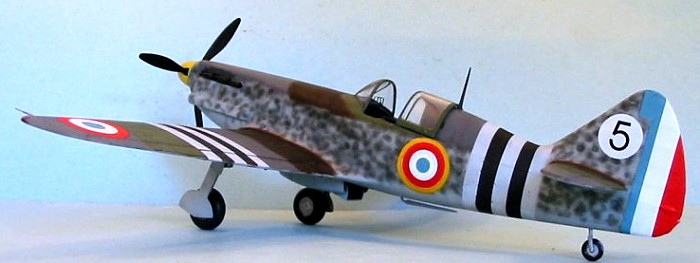
| KIT: | Azur 1/32 Dewoitine D.520 'High-Tech Interior' |
| KIT #: | A 043 |
| PRICE: | $54.00 MSRP |
| DECALS: | Three options |
| REVIEWER: | Tom Cleaver |
| NOTES: | Short run with resin parts |

| HISTORY |
The Dewoitine D.520 was the best fighter in the inventory of the Armee de l'Air at the time of the German invasion in May of 1940. Unfortunately, it was only just coming into service, and there were only a small number available.
The D.520 was designed in November 1936 by a team led by Emile Dewoitine - at that time director of a private design office - and was designed in response to a specification issued in 1937 for a single seat fighter. It was to have a maximum speed of 323 mph (520 km/hr), and the designation D.520 was assigned, with 520 the maximum speed in kilometers per hour. It was expected that the airplane would eventually be powered by the 1,200 hp engine under development by Hispano-Suiza.
The Dewoitine design office became part of the Societe Nationale de Construction Aeronatiques du Midi (SNCAM), when the French aviation industry was nationalized in 1937. The delays created by this event would be responsible for the D.520 not being available in needed numbers when war came. The first prototype flew on October 2, 1938 at Toulouse-Francazal with Chief Test Pilot Marcel Doret at the controls.
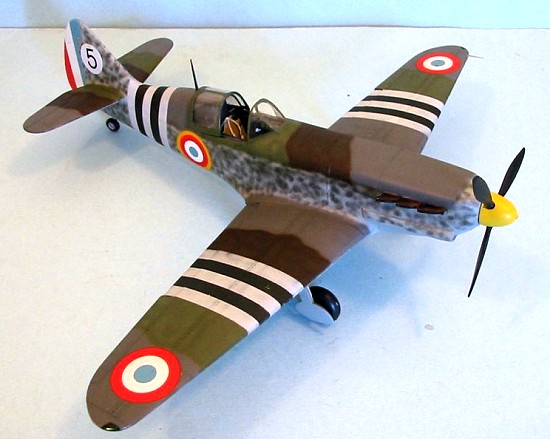 The second prototype
flew time on January 28, 1939, with a completely redesigned vertical tail,
sliding cockpit canopy, and armament of one 20mm cannon firing through the
propeller hub and two machine guns in gondolas under the wing. When powered
by a 12Y-31 engine in place of the original 12Y-29, maximum speed increased
to 341 mph at 17,060 feet, and it could climb to 26,240 feet in 12 minutes,
53 seconds.
The second prototype
flew time on January 28, 1939, with a completely redesigned vertical tail,
sliding cockpit canopy, and armament of one 20mm cannon firing through the
propeller hub and two machine guns in gondolas under the wing. When powered
by a 12Y-31 engine in place of the original 12Y-29, maximum speed increased
to 341 mph at 17,060 feet, and it could climb to 26,240 feet in 12 minutes,
53 seconds.
Flight trials went well, and an initial contract for 200 production D.520s powered by the 830 h.p. 12Y-31 engine - replaced later by the 910 h.p. 12Y-45 - was issued in March, 1939. A contract for an additional 600 D.520s was issued that June. Following the outbreak of war in September, a new contract brought the total to 1,280, with a production rate to be 200 machines per month as of May, 1940. The order was amended on April 19, 1940 for 2,250 D.520s with a production rate of 350 per month. 120 D.520s had been ordered by the Aeronavale in January, 1940.
Groupe de Chasse I/3 was the first to equip with the D.520, in January, 1940. The D.520 was popular, with pilots praising it for sensitivity of control, simplicity of the instrument panel, and ease of spin recovery. A D.520 was flown against a captured Bf-109E-3 on April 21, at Orleans-Bricy, the test revealed the Bf-109E-3 had a 20 mph speed advantage due to its more powerful engine, while the D.520 had superior maneuverability.
When the Germans invaded on May 10, 1940, only GC I/3 had e D.520s, while only 79 D.520s had been delivered. GC I/3 met the Luftwaffe for the first time on May 13, with the D.520s shooting down 3 Hs-126s and one He-111 without loss. During the following month, GC II/2, GC III/3, GC III/6 and GC II/7 received D.520s, and all saw service in the battle of France. GC II/6 and GC III/7 converted too late to see any action. By the Armistice of June 25, 1940, 437 D.520s had been produced, with 351 delivered to operational units. The D.520s scored 108 confirmed kills and 39 probables, for a loss of 85, with 54 due to direct enemy action.
Following the Armistice, the Vichy government was allowed to keep a reduced air force. No D.520 unit was to remain in service in Metropolitan France, so all surviving D.520 were sent to North Africa; GC I/3, II/3, III/6, and III/7 - as well as Aeronavale Escadrille 1AC - were allowed to remain in service.
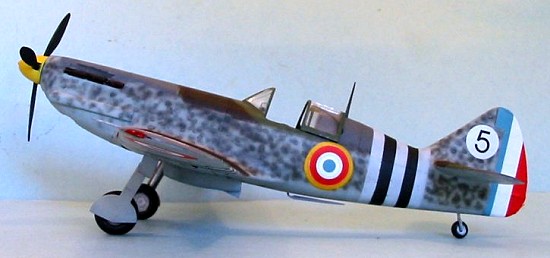 In April 1941, the
Germans allowed aircraft production to resume in Vichy France. SNCAM was
dissolved and the plants were absorbed by S.N.C.A. du Sud-Est (SNCASE).
The Vichy Air Force adopted the D.520 as its standard fighter, and
production of the D.520 to resume at Toulouse-Blagnac was allowed, with 550
D.520s ordered June 23, 1941, to replace all other single-seat fighters in
service.
In April 1941, the
Germans allowed aircraft production to resume in Vichy France. SNCAM was
dissolved and the plants were absorbed by S.N.C.A. du Sud-Est (SNCASE).
The Vichy Air Force adopted the D.520 as its standard fighter, and
production of the D.520 to resume at Toulouse-Blagnac was allowed, with 550
D.520s ordered June 23, 1941, to replace all other single-seat fighters in
service.
GC III/6 and II/3 saw combat against the Royal Air Force in Syria during June-July 1941, during which GC III/6 gained 19 confirmed victories and four probables, while GC II/2 had three confirmed victories and two probables, and Aeronavale Escadrille 1AC got eight victories. Vichy losses totaled 32 - 11 shot down, 12 lost in accidents, 7 destroyed in the ground, and two abandoned when the units flew back to French North Africa.
When the American invasion of North Africa came in November, 1942, 234 D.520s were in unoccupied France, with 93 serviceable, 173 were in North Africa, and 30 were in Senegal. French-based GC I/2 escaped to Meknes on November 9 with 24 aircraft to avoid capture by German forces. Air battles that included the D.520s of GC III/3 and II/5, Aeronavale 1AC, and the Hawk 75s of GC I/5 and II/5 resulted in the Aeronavale losing 19 D.520s, while the Air Force units lost 16 D.520s and Hawk 75s.
Responding to the Allied landings, the Germans invaded Unoccupied France, and on November 27th, all French armed forces were disbanded. 246 D.520s serving with Vichy units and 169 D.520s in various stages of completion at SNCASE were seized. Some were given to two Luftwaffe fighter training units, JG-103 and JG-105, where they were highly praised for their exceptional maneuverability, though the accident rate was fairly high, due to the differences between the D.520 and German aircraft.
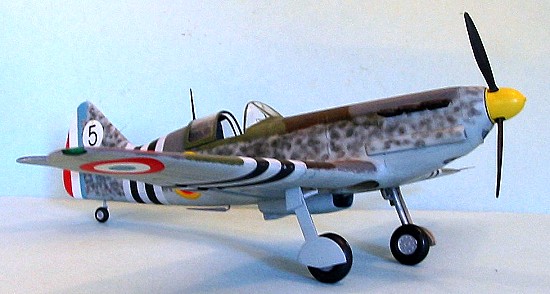 60 D.520s were sent
to the Regia Aeronautica where they were operated as fighter trainers. 100
D.520s were given to the Bulgarian Air Force, which used them
operationally against the U.S. 9th Air Force, where most were lost in
combat. The Romanian Air Force operated an squadron of D.520s on the
Eastern Front in 1943.
60 D.520s were sent
to the Regia Aeronautica where they were operated as fighter trainers. 100
D.520s were given to the Bulgarian Air Force, which used them
operationally against the U.S. 9th Air Force, where most were lost in
combat. The Romanian Air Force operated an squadron of D.520s on the
Eastern Front in 1943.
Following the invasion of Southern France in August 1944, Dewoitine test pilot Marcel Doret formed the Groupe Marcel Doret of the Forces Francaises de l’Interieur (FFI) with 55 D.520s liberated from the Luftwaffe, later reinforced by 20 brought back from North Africa. Doret led the Groupe in attacks on retreating German units and escorted Allied bombers, until the unit was re-equipped with the Spitfire Vb in March, 1945, and the D.520s were transferred to GC B I/18 and a training unit.
After the war, the D.520 served with training units in the revived Armee de l’Air, while several were converted to two-seat configuration under the designation D.520 DC (for "double commande"). The last unit to fly the D.520 was the Escadrille de Presentation de l’Armee de l'Air, which had flown Yak 3s brought to France by the Normandie-Niemen regiment. The last D.520 was withdrawn from service in September, 1953.
| THE KIT |
MPM released the D.520 as its first 1/32 kit last year. That release had a minimum of resin parts. This new release has a far more detailed cockpit, all in resin, that includes a very realistic pilot figure for those who like to populate their cockpits. Photo-etch seatbelts are also provided. Decals are included for the D.520 flown by Gabriel Gauthier of GC II/7 with the Vichy Air Force in North Africa in 1941 and 1942, and the D.520 flown by Marcel Doret himself in the fall of 1944.
| CONSTRUCTION |
As the first of the MPM 1/32 kits, this is not as well-done in overall plastic as the new P-36A is. However, this re-release provides a better-detailed resin cockpit, as well as photo-etched parts for the radiatiors and various intake screens as well as seat belts and the instrument panel.
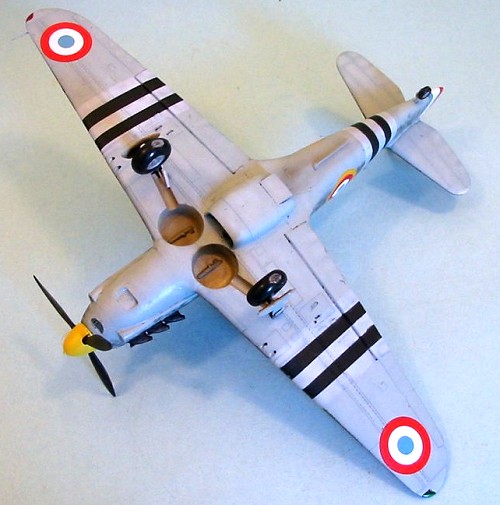 The kit has the fit
problems noted by Scott Van Aken in
his review of the first release. To me, the biggest problem is that
the fit of the wing subassembly to the fuselage subassembly will result in
complete loss of dihedral if you do not sand down both the wing root on the
fuselage and the butt of the upper wing to get things to the point where
the wing has a chance of bringing in the right dihedral. Additionally, the
lower one-piece wing does not have sufficient dihedral in the mold, so that
the modeler must bend it before assembling the wing further to get that
dihedral into the wing subassembly. If you do not do this, the model just
doesn’t look right.
The kit has the fit
problems noted by Scott Van Aken in
his review of the first release. To me, the biggest problem is that
the fit of the wing subassembly to the fuselage subassembly will result in
complete loss of dihedral if you do not sand down both the wing root on the
fuselage and the butt of the upper wing to get things to the point where
the wing has a chance of bringing in the right dihedral. Additionally, the
lower one-piece wing does not have sufficient dihedral in the mold, so that
the modeler must bend it before assembling the wing further to get that
dihedral into the wing subassembly. If you do not do this, the model just
doesn’t look right.
As with most models where the flaps are molded separately, the kit assembles best with the flaps lowered. If you choose to do what I did and raise the flaps, you need to leave out the backing piece in the wing, so that the flap can be pushed in enough to position it correctly. In the end, I discovered that the flap part is not as thick as the surrounding wing, so there is a definite “step” between the flap and the aileron. With the benefit of 20-20 hindsight, I would assemble this kit with the flaps dropped were I to do it again, even if the flaps were seldom left in the down position when the airplane was on the ground.
A final problem to be dealt with that the instructions do not mention is that the gear door is not one piece, but is rather two pieces, separated at the line where the door rakes forward. This is easy to fix if you look at photos and spot the situation, otherwise you end up with doors that do not fit, which plagued Scott’s project. It is also important to rake the gear legs forward - you have the legs at the proper angle when the rear lower angle of the gear door is horizontal to the ground with the model in the three-point position. It’s unfortunate that kit makers do not spend a bit more time in engineering the attachment of landing gear, as there is no better way of making a finished model look ridiculous than having the gear aligned improperly. This is also a great way to get your model dropped from further consideration after the judges make their first pass of the category in a competition.
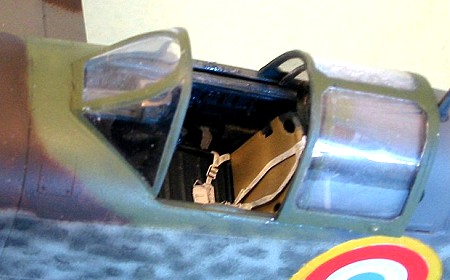 Other than the points
mentioned above, the model assembles easily for a limited-run kit, and the
extra detail of the resin cockpit is a vast improvement over what was
originally presented. The canopy is molded in one piece, which is
unfortunate if one wishes to display that nice cockpit. I separated the
canopy from the rear piece with a sharp X-acto, running it along the ridge
between the two surfaces from both sides until I could break the part
free. It was easy to separate the canopy from the windscreen with a razor
saw. When you do this, the canopy will fit easily in the open position.
Other than the points
mentioned above, the model assembles easily for a limited-run kit, and the
extra detail of the resin cockpit is a vast improvement over what was
originally presented. The canopy is molded in one piece, which is
unfortunate if one wishes to display that nice cockpit. I separated the
canopy from the rear piece with a sharp X-acto, running it along the ridge
between the two surfaces from both sides until I could break the part
free. It was easy to separate the canopy from the windscreen with a razor
saw. When you do this, the canopy will fit easily in the open position.
As with most limited-run kits, it’s a good idea to run cyanoacrylate glue over all the joints and seams, let it cure naturally, then sand it smooth. This insures the seams won’t reappear later at an inopportune moment. I follow this with a coat of Mr. Surfacer 500 to insure overall smoothness, then rescribe panel lines where necessary.
I also drilled out the gun ports in the wing, since these are just scribed.
| COLORS & MARKINGS |
Painting:
Since I had done a “Battle of France” French fighter with the Azur M.S.406,
and a “Vichy Air Force” Hawk 75, I decided to do this model in the markings
of Liberation, and so did the airplane flown by Marcel Doret in 1944-45.
This was an airplane 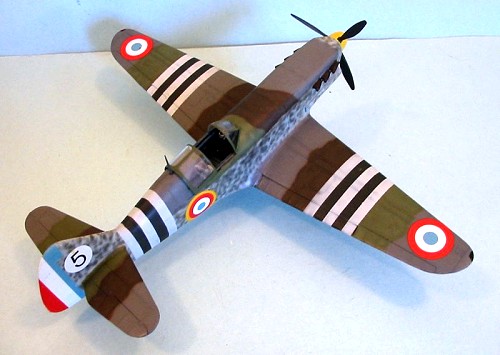 that
had been taken over by the Luftwaffe in 1942 and used for training, with
“Luftwaffe camouflage” applied to the fuselage sides and vertical fin over
the earlier French camouflage. As insurance against being shot down by
their erstwhile allies, the pilots of Groupe Doret also applied the
black-and-white D-Day stripes, half the width of the originals.
that
had been taken over by the Luftwaffe in 1942 and used for training, with
“Luftwaffe camouflage” applied to the fuselage sides and vertical fin over
the earlier French camouflage. As insurance against being shot down by
their erstwhile allies, the pilots of Groupe Doret also applied the
black-and-white D-Day stripes, half the width of the originals.
After pre-shading the model, which included painting the areas of the black D-Day stripes, I then masked them off in 9-inch stripes (3/8" in 1/32) and shot the white stripes. Applying white over the black gave a “ragged” look to these, which is the way they would have been, being applied over the original paint scheme. I also painted the rudder white, so there would be no problem in applying the tricolor rudder stripe decals later.
The lower surface and fuselage sides were painted with Xtracrylix RLM76 “Light Blue.” For the upper surfaces, I used Xtracrylix RLM81 “Braunviolett” for the brown area, Xtracrylix RLM62 “Green” for the green areas, and “RAF Dark Sea Grey” for the grey. The splotches on the fuselage and vertical fin were done with Xtracrylix RLM74 “Grey”.
When all this was dry, I unmasked the stripes and gave the model an overall coat of Future.
Decals:
I realized there was going to be trouble when I began to apply the fuselage insignia and saw that the yellow surround was not opaque. I slid the decal back onto its backing and let it float in the dish while I cut some circles the proper diameter from a sheet of white decal paper. I applied those, let them set up, then applied the kit decal over it and got a much better result. The other national insignia and the rudder stripes went on without difficulty.
| FINAL CONSTRUCTION |
I washed the model to get rid of decal solvent residue, then gave the model a coat of Xtracrylix Satin Varnish. When this was dry I followed with two coats of Xtracrylix Flat Varnish. I then painted the exhausts with Model Master “Burnt Iron” metalizer. I attached the prop blades, and the landing gear, being sure to get it at the proper angle of forward rake. I cut the gear doors and mounted them on the gear legs. I then unmasked the canopy and posed it in the open position.
| CONCLUSIONS |
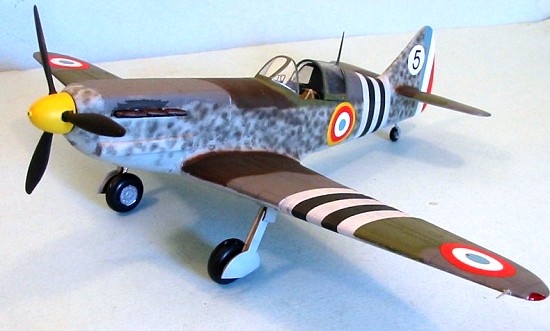 I think this
release, which was done in cooperation with French modelers who are very
knowledgeable about the D.520, is a great improvement over the original
release. The canopy is molded in one piece, but it took me 5 minutes with
an X-acto to separate the rear piece and then saw the canopy and windscreen
apart, and the sliding portion went over the rear section without problem.
I think this
release, which was done in cooperation with French modelers who are very
knowledgeable about the D.520, is a great improvement over the original
release. The canopy is molded in one piece, but it took me 5 minutes with
an X-acto to separate the rear piece and then saw the canopy and windscreen
apart, and the sliding portion went over the rear section without problem.
To me, the D.520 is the best-looking French fighter of the war, and an airplane that might have been as famous as the Spitfire had the Battle of France gone differently in 1940. It performed well in each battle it fought, always against the odds. I now have the three most famous French fighters of the war to add to my growing collection of 1/32 models. I highly recommend this release over the earlier release.
December 2005
Thanks to Hannants www.hannants.co.uk for the review kit.
If you would like your product reviewed fairly and quickly by a site that has over 300,000 visitors a month, please contact me or see other details in the Note to Contributors.